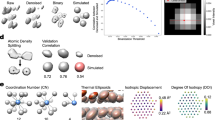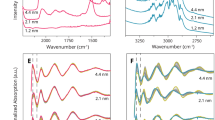Abstract
To fully understand the properties of functional nanostructures such as catalytic nanoclusters1, it is necessary to know the positions of all the atoms in the nanostructure2. The catalytic properties of metal nanoclusters can often be improved by the addition of a second metal3,4, but little is known about the role of the different metals in these bimetallic catalysts, or about their interactions with each other and the support material5. Here we show that aberration-corrected scanning transmission electron microscopy6,7 of supported rhodium–iridium clusters, combined with dynamic multislice image simulations, can identify individual atoms, map the full structure, and determine changes in the positions of metal atoms in sequential images. This approach could help in the development of new and improved catalysts and other functional nanostructures.
This is a preview of subscription content, access via your institution
Access options
Subscribe to this journal
Receive 12 print issues and online access
$259.00 per year
only $21.58 per issue
Buy this article
- Purchase on Springer Link
- Instant access to full article PDF
Prices may be subject to local taxes which are calculated during checkout




Similar content being viewed by others
References
Bell, A. T. The impact of nanoscience on heterogeneous catalysis. Science 299, 1688–1691 (2003).
Barth, J. V., Costantini, G. & Kern, K. Engineering atomic and molecular nanostructures at surfaces. Nature 437, 671–679 (2005).
Alexeev, O. S. & Gates, B. C. Supported bimetallic cluster catalysts. Ind. Eng. Chem. Res. 42, 1571–1587 (2003).
Sinfelt, J. H. Bimetallic Catalysts: Discoveries, Concepts, and Applications. (Wiley, 1983).
Rowsell, B. D., Trepanier, S. J., McDonald, R. & Cowie, M. Methylene-bridged complexes of rhodium/ruthenium as models for bimetallic Fischer–Tropsch catalysts: comparisons with the Rh/Os and Ir/Ru analogues. Organometallics 21, 3228–2337 (2002).
Shibata, N. et al. Observation of rare-earth segregation in silicon nitride ceramics at subnanometre dimensions. Nature 428, 730–733 (2004).
Nellist, P. D. et al. Direct sub-angstrom imaging of a crystal lattice. Science 305, 1741 (2004).
Chandler, B. D., Schabel, A. B. & Pignolet, L. H. Preparation and characterization of supported bimetallic Pt–Au and Pt–Cu catalysts from bimetallic molecular precursors. J. Catal. 193, 186–198 (2000).
Datye, A. K. Electron microscopy of catalysts: recent achievements and future prospects. J. Catal. 216, 144–154 (2003).
Nellist, P. D. & Pennycook, S. J. Direct imaging of the atomic configuration of ultradispersed catalysts. Science 274, 413–415 (1996).
Wang, S. W. et al. Dopants adsorbed as single atoms prevent degradation of catalysts. Nature Mater. 3, 143–146 (2004).
Kwak, J. H. et al. Coordinatively unsaturated Al3+ centers as binding sites for active catalysts phases of platinum on γ-Al2O3 . Science 325, 1670–1673 (2009).
Bashyam, R. & Zelenay, P. A class of non-precious metal composite catalysts for fuel cells. Nature 443, 63–66 (2006).
Billinge, S. J. L. & Levin, I. The problem with determining atomic structure at the nanoscale. Science 316, 561–565 (2007).
Garner, C. D. X-ray absorption spectroscopy. Nature 277, 89–90 (1979).
Moggridge, G. D., Rayment, T., Ormerod, R. M., Morris, M. A. & Lambert, R. M. Spectroscopic observation of a catalysts surface in a reactive atmosphere at high pressure. Nature 358, 658–660 (1992).
Argo, A. M., Odzak, J. F., Lai, F. S. & Gates, B. C. Observation of ligand effects during alkene hydrogenation catalysed by supported metal clusters. Nature 415, 623–626 (2002).
Pennycook, S. J., Varela, M., Hetherington, C. J. D. & Kirkland, A. I. Materials advances through aberration-corrected electron microscopy. MRS Bull. 31, 36–43 (2006).
James, E. M. & Browning, N. D. Practical aspects of atomic resolution imaging and analysis in STEM. Ultramicroscopy 78, 125–139 (1999).
Herzing, A. A., Kiely, C. J., Carley, A. F., Landon, P. & Hutchings, G. J. Identification of active gold nanoclusters on iron oxide supports for CO oxidation. Science 321, 1331–1335 (2008).
Kirkland, E. J. Advanced Computing in Electron Microscopy (Plenum, 1998).
Acknowledgements
This work was supported by the National Science Foundation (NSF, grant no. CTS-0500511 to V.O.), by the US Department of Energy (DOE, grant no. DE-FG02-04ER15600 to A.U.) and by ExxonMobil. The STEM images were acquired at Oak Ridge National Laboratory's Shared Research Equipment User Facility, supported by the Division of Scientific User Facilities, Basic Energy Sciences, DOE.
Author information
Authors and Affiliations
Contributions
V.O. performed the experiments and wrote the paper. A.U. performed synthesis of the catalyst samples. V.O., A.U., B.C.G. and N.D.B. conceived and designed the experiments. All authors discussed the results and commented on the manuscript.
Corresponding author
Ethics declarations
Competing interests
The authors declare no competing financial interests.
Supplementary information
Supplementary information
Supplementary information (PDF 1663 kb)
Supplementary information
Supplementary movie (AVI 11492 kb)
Rights and permissions
About this article
Cite this article
Ortalan, V., Uzun, A., Gates, B. et al. Towards full-structure determination of bimetallic nanoparticles with an aberration-corrected electron microscope. Nature Nanotech 5, 843–847 (2010). https://doi.org/10.1038/nnano.2010.234
Received:
Accepted:
Published:
Issue Date:
DOI: https://doi.org/10.1038/nnano.2010.234
This article is cited by
-
Thermal property and failure behaviors of Gd doped LaZrCeO coatings with feathery microstructure
npj Materials Degradation (2022)
-
Material structure, properties, and dynamics through scanning transmission electron microscopy
Journal of Analytical Science and Technology (2018)
-
Superdislocations and point defects in pyrochlore Yb2Ti2O7 single crystals and implication on magnetic ground states
Scientific Reports (2018)
-
Applying shot boundary detection for automated crystal growth analysis during in situ transmission electron microscope experiments
Advanced Structural and Chemical Imaging (2017)
-
Electric field imaging of single atoms
Nature Communications (2017)



